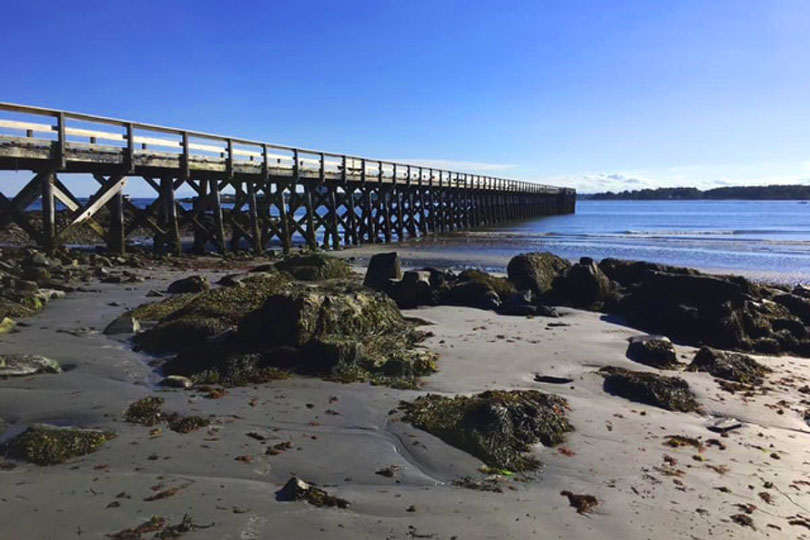From November to April, there’s no place like the great indoors. Call it coziness, comfort, or hygge; until April comes, I’m mostly content to watch winter drift by from the heated side of my big picture window.
But there’s a limit. The four walls of my room can start to feel more like a prison than a refuge, and even the strong winds and arctic temperatures won’t keep me inside all winter.
It’s natural to want to walk in town, to stick to the shoveled sidewalks that wind past cafes where I can hide from the weather. Once in a while, though, I need to immerse myself in nature – to see the bare trees, to marvel at the things that still grow, and to watch the waves roll onto lonesome stretches of the seashore.
Fort Foster in Kittery is one of my favorite walking spots. Just over the bridge and out to Kittery Point, this 88-acre gem offers a generous stretch of rocky coastline and views of the harbor, Whaleback Light, the old lifesaving station and the Isles of Shoals.

The park has a playground, picnic tables, a large picnic shelter, and a 560-foot pier. It also has a long history as a military site, dating back to the 19th century.
Military use
The website northamericanforts.com has an abundance of information about Fort Foster. According to the website, the US government acquired the land for Fort Foster in 1872. Originally, the fort was supposed to be an earthen and concrete battery where 12 guns would be housed.
It was to be named Battery Berry, after Major General Hiram G. Berry, who was killed in Virginia during the Civil War. The battery was never completed.
After the Spanish American War, the government felt the need to secure the harbor and protect the shipyard. Concrete batteries were built, and guns were installed.
The site was named Fort Foster, after another Civil War hero, Brevet Major General John G. Foster.

Foster’s military career was admirable. He served in the Mexican-American War and the Civil War, helped build Fort Sumter and was no stranger to combat nor courage.
During a Confederate siege on Washington, North Carolina, Foster took command of the city’s defenses. When the Confederate commander demanded his surrender, Foster replied, “You want Washington, come and get it.”
Fort Foster and the World Wars
Activity at the fort grew during the World Wars. All three guns from Battery Bohlen were removed during World War I, and were supposed to be sent to France for use as railway guns.
They only made it to the arsenal in Watertown, MA, and came back to Fort Foster after the war. Soldiers said the guns never worked right again.
During World War II, the Army obtained additional land for the fort. A new battery was constructed there, on the site of the former Pocahontas Hotel.
Other improvements included a command post and observation station, barracks, and a mess hall. 103 soldiers from the 22nd Coast Artillery Regiment manned Fort Foster during the war.
Some of the military installations from various periods are still visible. During low tide, wooden structures emerge from the water.
These wooden platforms were part of a machine gun installation, to be used against torpedo boats in the event of an invasion or attack.
I highly recommend the article on northamericanforts.com (see link below). There is little information at the park itself about the park’s military past. Several structures remain, some imposing, some crumbling, all testifying to the site’s strategic importance during times of crisis.
Many people served here. It might have been a lonely assignment, and a hard one, with the exposure to the wind and the need for constant vigilance.
Stretch your legs…and your imagination
I can only imagine what it must have been like. That’s part of the attraction of the place – really, of any good park.
As Frederick Law Olmsted, designer of New York’s Central Park, once said, “A great object…of all the art of a park, is to influence the mind of men through their imagination…”
What better way to inspire the imagination and divert the soul from its winter woes, than to engage the imagination and walk along the shore, past command towers and batteries, and to feel grateful to live in peacetime? Such luxuries were denied to generations.
Fort Foster is open year-round. Tickets may be purchased at the gate during the summer. Year-round passes are also available here: https://epay.cityhallsystems.com/
The park closes at dusk. For more information about the park, see https://www.kitteryme.gov/fort-foster-park
The website northamericanforts.com provides detailed information about Fort Foster. See https://www.northamericanforts.com/East/Maine/Fort_Foster/history.html
Featured image courtesy of kitteryme.gov










